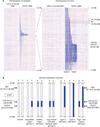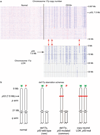The biology and clinical significance of acquired genomic copy number aberrations and recurrent gene mutations in chronic lymphocytic leukemia
- PMID: 23001040
- PMCID: PMC3676480
- DOI: 10.1038/onc.2012.411
The biology and clinical significance of acquired genomic copy number aberrations and recurrent gene mutations in chronic lymphocytic leukemia
Abstract
Chronic lymphocytic leukemia (CLL) is the most common leukemia in the Western world and remains incurable with conventional chemotherapy treatment approaches. CLL as a disease entity is defined by a relatively parsimonious set of diagnostic criteria and therefore likely constitutes an umbrella term for multiple related illnesses. Of the enduring fundamental biological processes that affect the biology and clinical behavior of CLL, few are as central to the pathogenesis of CLL as recurrent acquired genomic copy number aberrations (aCNA) and recurrent gene mutations. Here, a state-of-the-art overview of the pathological anatomy of the CLL genome is presented, including detailed descriptions of the anatomy of aCNA and gene mutations. Data from SNP array profiling and large-scale sequencing of large CLL cohorts, as well as stimulated karyotyping, are discussed. This review is organized by discussions of the anatomy, underlying pathomechanisms and clinical significance of individual genomic lesions and recurrent gene mutations. Finally, gaps in knowledge regarding the biological and clinical effects of recurrent genomic aberrations or gene mutations on CLL are outlined to provide critical stimuli for future research.
Figures



References
-
- Shanafelt TD, Hanson C, Dewald GW, Witzig TE, LaPlant B, Abrahamzon J, et al. Karyotype evolution on fluorescent in situ hybridization analysis is associated with short survival in patients with chronic lymphocytic leukemia and is related to CD49d expression. J Clin Oncol. 2008;26:e5–e6. - PMC - PubMed
-
- Dohner H, Stilgenbauer S, Benner A, Leupolt E, Krober A, Bullinger L, et al. Genomic aberrations and survival in chronic lymphocytic leukemia. N Engl J Med. 2000;343:1910–1916. - PubMed
-
- Pettitt AR, Jackson R, Carruthers S, Dodd J, Dodd S, Oates M, et al. Alemtuzumab in combination with methylprednisolone is a highly effective induction regimen for patients with chronic lymphocytic leukemia and deletion of TP53: Final results of the National Cancer Research Institute CLL206 Trial. J Clin Oncol. 2012;30:1647–1655. - PubMed
-
- Spaner DE. Oral high-dose glucocorticoids and ofatumumab in fludarabine-resistant chronic lymphocytic leukemia. Leukemia. 2012;26:1144–1145. - PubMed
-
- Stilgenbauer S, Zenz T, Winkler D, Buhler A, Schlenk RF, Groner S, et al. Subcutaneous alemtuzumab in fludarabine-refractory chronic lymphocytic leukemia: clinical results and prognostic marker analyses from the CLL2H study of the German Chronic Lymphocytic Leukemia Study Group. J Clin Oncol. 2009;27:3994–4001. - PubMed
Publication types
MeSH terms
Grants and funding
LinkOut - more resources
Full Text Sources

